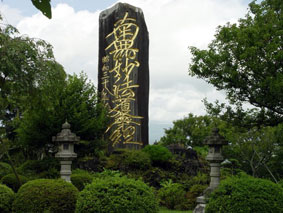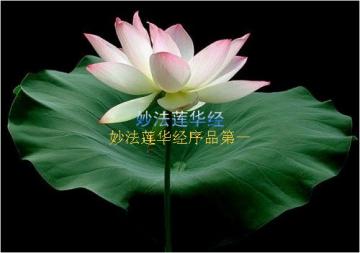
History and background
The Lotus Sutra was probably compiled in the first century BCE in Kashmir, India some 500 years after the Parinirvana of Shakyamuni Buddha. Therefore, it is probably not included in the more ancient Āgamas nor in the parallel Sutta Pitaka of the Theravada Buddhists, both of which represent the older Buddhist scriptures which to a greater degree of certainty can be historically linked to the Buddha himself.
The Lotus Sutra purports to be a discourse delivered by the Buddha toward the end of his life. The tradition in Mahayana states that the Lotus Sutra was written down at the time of the Buddha and stored for five hundred years in the realm of the dragons (or Nagas). After this, they were reintroduced into the human realm at the time of the Fourth Buddhist Council in Kashmir. The tradition further claims that the teachings of the Lotus Sutra are higher than the teachings contained in the agamas and the Sutta Pitaka (the Sutra itself also claims this), and that humankind had been unable to understand the Lotus Sutra at the time of the Buddha (500 BCE).
Several years ago western scholars began examining the collection of Buddhist texts acquired by the Schoyen collectors. Several scholars have noticed fragments from the Lotus Sutra that predate the earliest Christian gospels in Greek.[citation needed] These scholars have not released much on these fragments, except to say that they are not dependent on the Chinese or Tibeten Lotus sutras. Furthermore, other scholars have noted how the cryptic Dharani passages within the Lotus sutra represent a form of the Magadhi dialect that is more similar to Pali than Sanskrit. For instance, one Dharani reads in part: “Buddhavilokite Dharmaparikshite”. Although the vilo is attested in Sanskrit, it appears first in the Buddhist Pali texts as “vilokita” with the meaning of “a vigilant looker” from vi, meaning eager like a passionless bird, and lok, meaning “look”.
Translation and Composition
The Lotus Sutra was originally translated from Sanskrit, with many traces of an earlier Prakrit version, into Chinese by Dharmarakṣa around 209 CE, before being superseded by a translation in seven fascicles by Kumārajīva in 406 CE. The Chinese title is usually abbreviated to 法華經, which is read Făhuā Jīng in Chinese and Hokekyō in Japanese, Beophwagyeong in Korean, and Pháp Hoa Kinh” in Vietnamese. The Sanskrit copies are not widely used outside of academia. It has been translated by Burton Watson. According to Burton Watson it may have originally been composed in a Prakrit dialect and then later translated into Sanskrit to lend it greater respectability.
This sutra is well-known for its extensive instruction on the concept and usage of skillful means (Sanskrit: upāya; Jp: hōben), mostly in the form of parables. It is also one of the first sutras to use the term Mahāyāna, or “Great Vehicle” Buddhism. Another concept introduced by the Lotus Sutra is the idea that the Buddha is more of an eternal entity, who achieved nirvana eons ago, but willingly chose to remain in the cycle of rebirth to help teach beings the Dharma time and again. He reveals himself as the “father” of all beings and evinces the loving care of just such a father. Moreover, the sutra indicates that even after the Parinirvana (apparent physical death) of a Buddha, that Buddha continues to be real and to be capable of communicating with the world. The idea that the physical death of the / a Buddha is the termination of that Buddha is graphically refuted by the movement and meaning of this scripture, in which another Buddha, who “parinirvana-ed” long before, appears and communicates with Shakyamuni himself. In the vision of the Lotus Sutra, Buddhas are ultimately immortal. A similar doctrine of the eternity of Buddhas is repeatedly expounded in the tathāgatagarbha sutras, which share certain family resemblances in spirit to the teachings of the Lotus Sutra.
The Lotus Sutra also indicates (Chapter 4) that emptiness (śūnyatā) is not the ultimate vision to be attained by the aspirant Bodhisattva: the attainment of Buddha Wisdom is indicated to be a bliss-bestowing treasure which transcends seeing all as merely empty.
In terms of literary style, the Lotus Sutra illustrates a sense of timelessness and the inconceivable, often using large numbers and measurements of time and space. Some of the other Buddhas mentioned in the Lotus Sutra are said to have lifetimes of dozens or hundreds of kalpas, while the number of Bodhisattvas mentioned in the “Earth Bodhisattva” chapter number in the billions, if not more. The Lotus Sutra also often alludes to a special teaching that supersedes everything else that the Buddha has taught, but the Sutra never actually states what that teaching is. This is said to be in keeping with the general Mahāyāna Buddhist view that the highest teaching cannot be expressed in words.
The ultimate “teaching” of the sutra, however, is implied to the reader that “full Buddhahood” is only arrived at by exposure to the truths expressed implicitly in the Lotus Sutra via its many parables and references to a heretofore less clearly imagined cosmological order. Skillful means of most enlightened Buddhas is itself the highest teaching (the “Lotus Sutra” itself), in conjunction with the sutra’s stated tenets that all other teachings are subservient to, propagated by and in the service of this highest truth and teaching aimed at creating “full Buddhas” out of pratyetkabuddhas, lesser buddhas and bodhisattvas. It is also implied in sections of the text that there is a parent-child relationship existing between the innumerable Buddhas and human beings and other types of beings, with an explicit indication that all religions and paths are in some way or another part of the skillful means of this highest Buddha Dharma which reaches its expressed pinnacle in the Lotus Sutra. Buddhism, as expressed in the Lotus Sutra, therefore logically comes to inherit the traditions of Christianity, Islam, Judaism and all other Abrahamic religions. The various religious institutions and their doctrinal proponents notwithstanding, all paths are then, officially speaking, part of the skillful means and plan of Buddhism, thus the sutra’s former disavowal of all competitive doctrinal disputes.
It is worth noting that not only are there more than one, but it is repeadtedly alluded to that there is an infinite stream of Buddhas extending through eons of time (“thousands of kotis of kalpas”, etc.) in what seems to be an endless cycle of creations of the universe and conflagrations. This would seem to imply that the project of the enlightenment of all beings is something very organized, if rough-going in actualization.
Likewise, not only are Buddhas gleaned to be innumerable if we take the Lotus sutra at its word, but realms of gods, devas, dragons and other mythological beings referred to are quite diverse and the required dimensions to hold them all are quite numerous. Buddhas are the patient teachers of all such beings, somewhat like a regional director of a universal education program, using all sorts of lower management and various means at their disposal and the actual negative and positive karma of beings itself as working material.
Some sources consider that the Lotus Sutra has a prologue and an epilogue, these being respectively the Innumerable Meanings Sutra (無量義經 Jp: Muryōgi Kyō) and the Sutra of Meditation on the Bodhisattva Universal Worthy (普賢經 Jp: Fugen Kyō).

Translations in Western languages
Burnouf, Eugène (tr.). Le Lotus de la Bonne Loi. Paris 1852 (Imprimerie Nationale) – French translation from Sanskrit, first in Western language.
Katō Bunno, Tamura Yoshirō, Miyasaka Kōjirō (tr.), The Threefold Lotus Sutra: The Sutra of Innumerable Meanings; The Sutra of the Lotus Flower of the Wonderful Law; The Sutra of Meditation on the Bodhisattva Universal Virtue. New York & Tōkyō 1975 (Weatherhill & Kōsei Publishing).
Kern, H. (tr.). Saddharma Pundarîka or the Lotus of the True Law; Oxford 1884 (Clarendon Press) Sacred Books of the East, Vol. XXI, New York 1963 (Dover), Delhi 1968. Translation from Sanskrit.
Hurvitz, Leon (tr.). Scripture of the Lotus Blossom of the Fine Dharma: The Lotus Sutra. New York 1976 (Columbia University Press) Records of Civilization: Sources and Studies. Translation from the Chinese of Kumārajīva.
Kubo Tsugunari and Yuyama Akira (tr.) The Lotus Sutra. Revised 2nd ed. Berkeley, Calif. : Numata Center for Buddhist Translation and Research, 2007. Translation from the Chinese of Kumārajīva. ISBN 9781886439399
Kuo-lin Lethcoe (ed.). The Wonderful Dharma Lotus Flower Sutra with the Commentary of Tripitaka Master Hsuan Hua. Translated by the Buddhist Text Translation Society. San Francisco 1977 (Buddhist Text Translation Society). Translation from the Chinese of Kumārajīva.
Soothill, W. E. (tr.). The Lotus of the Wonderful Law or The Lotus Gospel. Oxford 1930 (Clarendon Press). Abridged translation from the Chinese of Kumārajīva.
Murano Senchū (tr.). The Sutra of the Lotus Flower of the Wonderful Law Tokyo 1974 (Nichiren Shu Headquarters). Translation from the Chinese of Kumārajīva.
Watson, Burton (tr.). The Lotus Sutra. New York 1993 (Columbia University Press) Translations from the Asian Classics. Translation from the Chinese of Kumārajīva.
Tanabe, George J. & Tanabe, Willa Jane (ed.); The Lotus Sutra in Japanese Culture; Honolulu 1989 (University of Hawaii Press), ISBN 0-8248-1198-4 [II, 15] (Not a translation, but a collection of essays on Lotus Sutra & Japanese culture.)
– Buddhachannel Diffusion – www.buddhachannel.tv




